Quartz monzodiorite
Category: Plutonic
Type Pyroxenic-biotitic quartz monzodiorite.
Commons Quartz monzodiorite is plutonic rock composed of sodic plagioclase, alkali feldspar, quartz and mafic minerals (hornblend, biotite, augite).
Name origin Rootname of the rock is derived from diorite, from which it differs slightly in terms of modal and chemical compositions. The name of diorite comes from Greek diorizein – to differ – and was mentioned for the first time by D´Aubuission de Voisins in 1819.
Locality Štěpánovice, Skalice quarry, České Budějovice district, Czech Republic (collection of Š. Dávidová).
GPS: 48° 59' 9,47" N, 14° 41' 1,29" E
Major minerals Two types of plagioclases have been distinguished. The first type is represented by euhedral to subhedral plagioclase, 0.5-1 mm in size, chemically zoned, with labrador to bytownite - An50-90 - in cores and albite-to-oligoclase - An0-30 - in margins. The second type is represented by euhedral plagioclase, up to 0.5 mm in size, with andesine An50-90 cores and albite An0-10 margins. K-feldspar locally forms microperthitic overgrowths with quartz. Augite is replaced by magnesiohornblend and chloritized biotite.
Accessory minerals Ilmenite, apatite, zircon, baddeleyite, allanite, monazite, sulphides (pyrrhotite, pentlandite, gersdorffite, chalcopyrite, sphalerite, galena.
Classification The field of quartz monzodiorite is defined in the QAPF classification of plutonic rocks (Streckeisen 1976) by content of modal quartz (Q 5 – 20 %) and P/(P + A) ratio between 65 and 90 %, and according to chemical-mineralogical classification of Debon – Le Fort (1983).
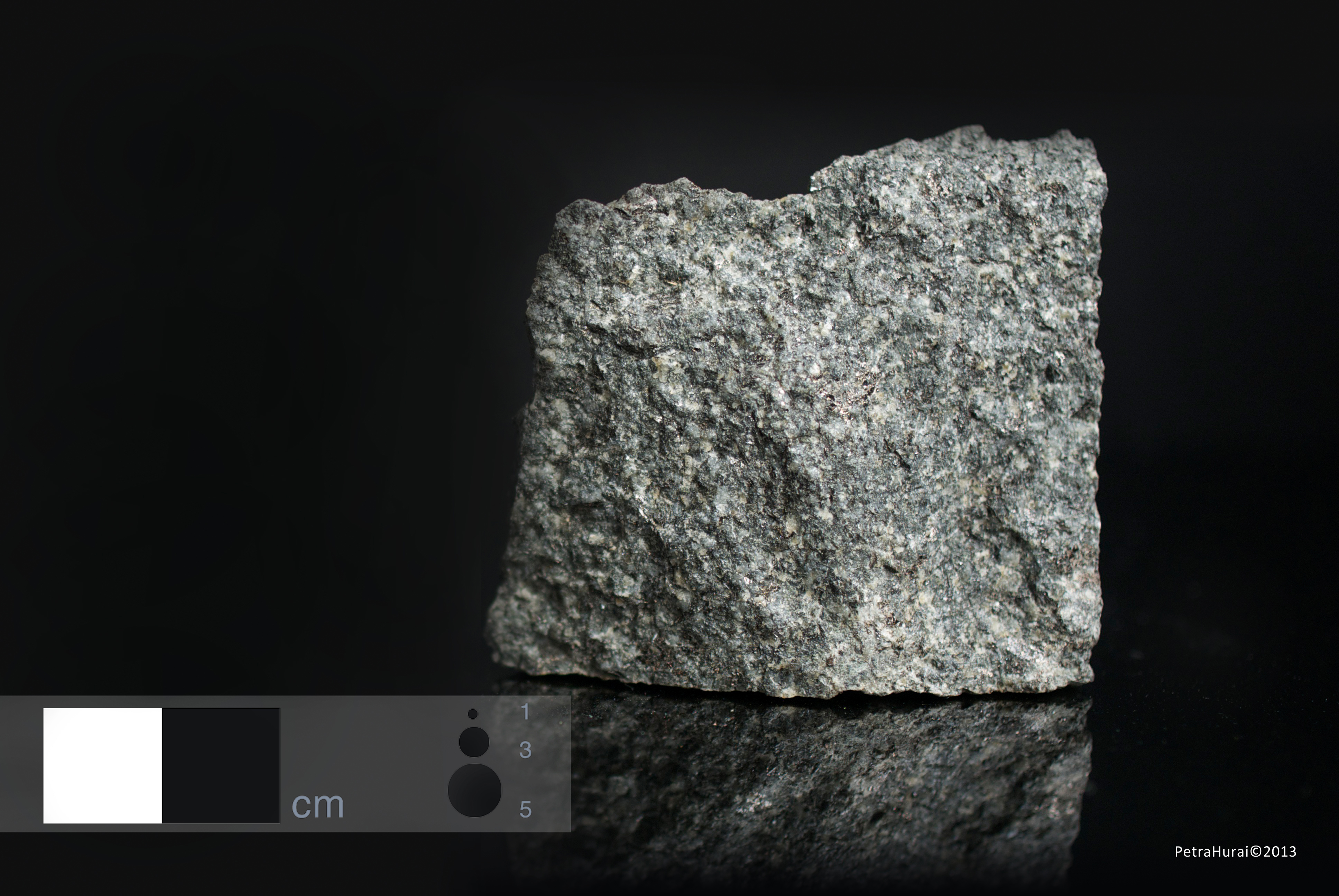
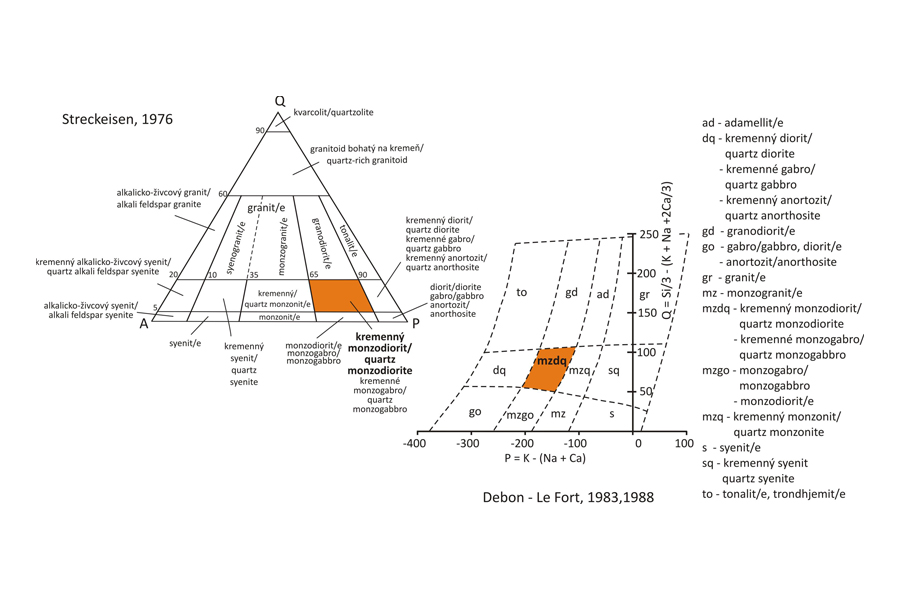
Colour Dark blue-grey.
Structure Massive, confining.
Granularity Fine grained (0,1 - 1 mm) to medium-grained (1 - 3 mm).
Texture Phaneritic, subhedrally grained, sub-offitic.
Alterations The rock is relatively fresh, plagioclases are only slightly sericitized and biotite chloritized. Sericite, chlorite, prehnite, calcite, epidote and rarely titanite are secondary minerals.
Petrographic characteristics The rock contains macroscopic plagioclase laths, black-brown biotite (1-3 mm) and sub-microscopic, dark green clinopyroxene. Quartz monzodiorite is heterogeneous, with abundant inclusions of various types. Frequent are spherulitic cavities, 3-5 mm in size, filled with secondary chlorite and actinolite. Less frequent to rare Al-rich inclusions, up to several mm in diameter, are composed of hercynite, corundum, diaspore, and sillimanite embedded in plagioclase matrix together with secondary muscovite. Leucogranitic rock inclusions were described very rarely in several samples.
Usage Diorite is harder than granite and its processing was problematic in ancient cultures. In medieval times, diorite balls were used to the treatment of other rocks and other applications involved production of statues, cobbles and the building of defense walls. The Chamurapiʼs code was carved in a diorite monolith – the World famous diorite seen nowadays in the exhibitions of Louvre. Owing to its resistance, diorite had also rarely been used as a mean of payements. It is recently utilized as cladding material, cobbles, boards and tombstones.
Literature Vrána, S. & Janoušek, V., 2006: Late-orogenic Variscan magmatism: the case study of quartz monzodiorite dykes from the Blanice Graben, southern Bohemia. Journal of the Czech Geological Society, 51, 3-4, 213-248. Debon, F. & Le Fort, P., 1983:. A chemical-mineralogical classification of common plutonic rocks and associations. Transactions of the Royal Society of Edinburgh, Earth Sciences, 73, 135-149. Debon, F. & Le Fort, P., 1988: A cationic classification of common plutonic rocks and their magmatic associations: principles, method, applications. Bulletin de Minéralogie, 111, 493-510.
Photomicrographs
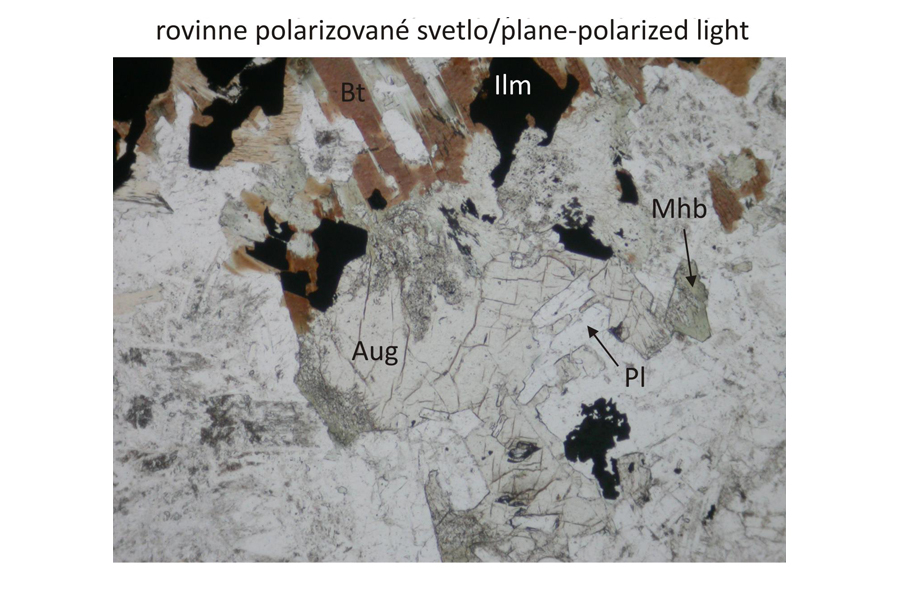
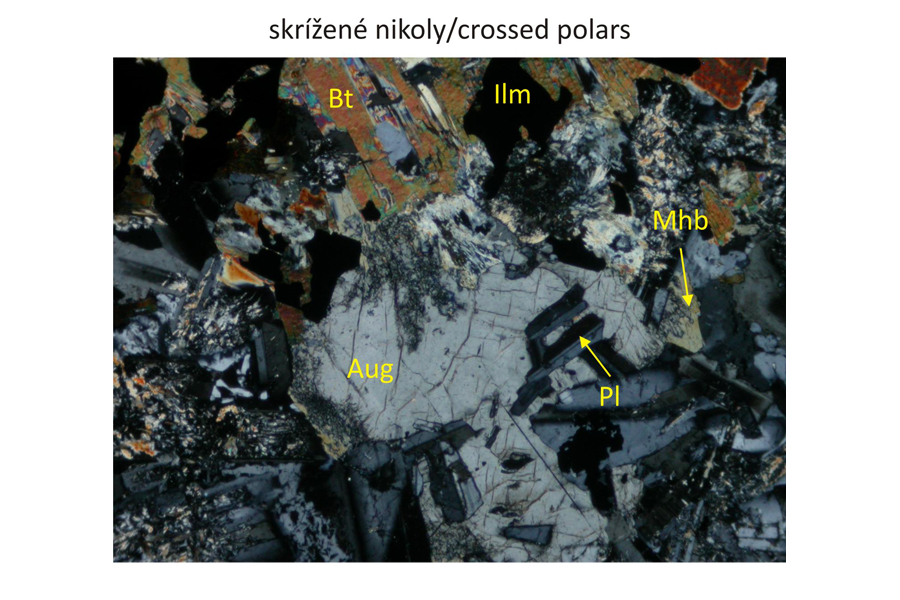
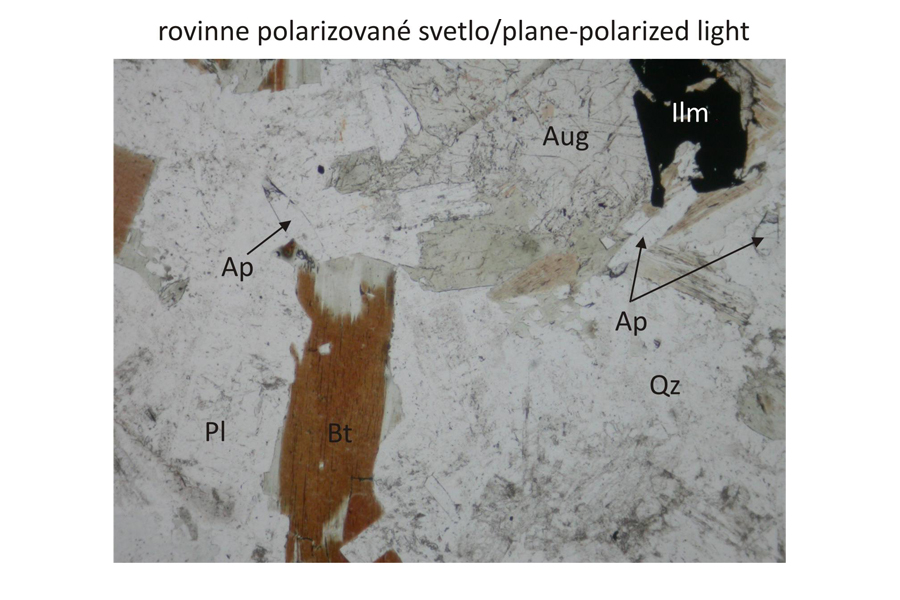
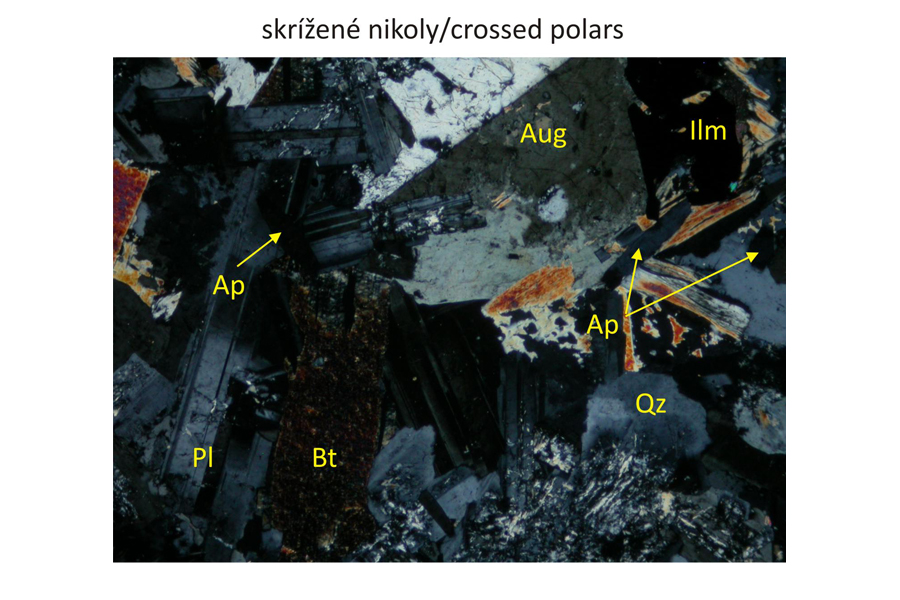
Subophitic structure created by plagioclase laths – Pl, completely or partly enclosed in augite – Aug. The augite is replaced along margins by green magnesiohornblend – MhB – with faint green-yellow pleochroism observed under unpolarized light. Phenocrystals of biotite – Bt with a pronounced brown colour and pleochroism observed under unpolarized light are moderately chloritized. Ilmenite –Ilm – and apatite – Ap – are the most important accessory minerals. The apatite exhibits in crossed polars a low-order interference colour and the sections perpendicular to optical axis are extinct (apatite on the right side of the image). This behaviour is due to hexagonal symmetry of apatite and the coincidence of the optical axis with the crystallographic z-axis.
Normative composition
The rock is oversaturated with quartz. It contains normative quartz q and normative hypersthene – hy. Normative fluorite fl calculated from F and normative pyrite pr calculated from S content occur in the norm together with other common normative minerals. The rock is metaluminous, what is projected in the normative corundum – c.
Normative minerals
SiO2
TiO2
ZrO2
Al2O3
Fe2O3
FeO
MnO
MgO
CaO
Na2O
K2O
P2O5
F
S
CO2
Total
Molar proportion of normative mineral
Molecular mass of normative mineral
Weight % of normative mineral
Oxide
(wt. %)
51.50
1.59
15.64
1.03
7.53
0.14
6.73
6.96
2.52
2.39
0.44
0.06
0.16
0.10
96.73
Molecular
weight
60.08
79.88
101.96
159.69
71.85
70.94
40.31
56.08
61.98
94.20
141.95
19.00
32.06
44.01
Molecular
proportion
0.8572
0.0199
0.1534
0.0064
0.1068
0.0020
0.1670
0.1241
0.0407
0.0254
0.0031
0.0032
0.0050
0.0023
ap
0.0103
0.0031
0.0031
328.70
1.02
pr
0.0025
0.0050
0.0025
119.98
0.30
il
0.0199
0.0199
0.0199
151.75
3.02
fl
0.0016
0.0032
0.0016
78.07
0.12
cc
0.0023
0.0023
0.0023
100.09
0.23
or
0.1522
0.0254
0.0254
0.0254
556.67
14.12
ab
0.2440
0.0407
0.0407
0.0407
524.46
21.32
an
0.1747
0.0874
0.0874
0.0874
278.21
24.31
mt
0.0064
0.0064
0.0064
231.54
1.49
zvyšky
0.0779
0.1670
di
0.0451
0.0072
0.0154
0.0226
0.0226
226.60
5.11
hy
0.2223
0.0707
0.1516
0.2223
110.43
24.55
q
0.0189
0.0189
60.08
1.14
D: -0.0188
Mg/(Mg+Fe2+): 0.682
Total of normative wt. % 96.73
Comment All standard normative minerals were created and the norm calculation ended with normative quartz.
Chemical composition
Compared to granite, the quartz monzodiorite has lower SiO2 contents, around 50 wt. %. I tis metaluminous, high-potassium, calc-alkaline rock slightly enriched in LREE. Typical are also low Nb, Ti and P concentrations that are diagnostic of volcanic-arc magmas. The monzodiorite magma originate by a decompression melting of sub-lithospheric mantle modified by subduction. Sr-Nd isotope data reveal also assimilation of crustal material during ascent of relatively primitive and slightly enriched magma derived from the mantle.
-
SiO2
51.50TiO2
1.59Al2O3
15.64Fe2O3
1.03FeO
7.53MnO
0.14MgO
6.73CaO
6.96Na2O
2.52K2O
2.39P2O5
0.44H2O+
2.95H2O-
0.10CO2
0.10SO3
0.40F
0.06Total
100.08Mg(Mg/Fe2+)
0.61A/CNK
0.81A/NK
2.32
Vrána - Janoušek, 2006.
-
SiO2
51.88TiO2
1.48Al2O3
15.93Fe2O3
0.99FeO
6.85MnO
0.12MgO
6.45CaO
6.81Na2O
2.39K2O
2.52P2O5
0.48H2O+
3.12H2O-
0.23CO2
0.07SO3
0.17F
0.07Total
99.57Mg(Mg/Fe2+)
0.63A/CNK
0.84A/NK
2.39
Vrána - Janoušek, 2006.


